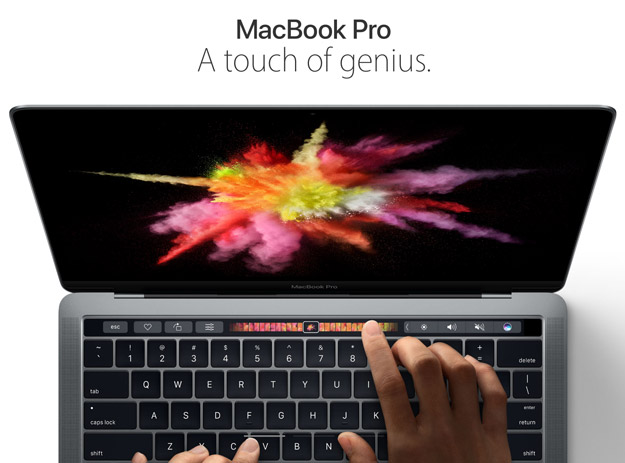Apple MacBook Pro Graphics Horsepower More Like A Pinto Than A Porsche

On the surface, the new MacBook Pros seems like a steady evolution of its predecessors, and continues Apple’s penchant for making its devices thinner and lighter. Apple shaved half a pound in weight from each MacBook Pro and a few millimeters in thickness. This also means that battery capacity is down on all three MacBook Pro models announced last week:
- 15-inch MacBook Pro (2015): 99.5 WHr battery
- 15-inch MacBook Pro (2016): 76 WHr battery
- 13-inch MacBook Pro (2015): 74.9 WHr battery
- 13-inch MacBook Pro (2016): 54.5 WHr battery
- 13-inch MacBook Pro with Touch Bar (2016): 49 WHr battery
Every computing device is an exercise in compromise, and the MacBook Pro definitely comes up on the short end of the stick with regards to graphics. AMD proudly announced that the 15-inch MacBook Pros are using 14nm Polaris-based Radeon Pro 400 series mobile GPUs. Machines are equipped with a Radeon Pro 450 with 2GB of GDDR5 memory or a Radeon Pro 455 with 2GB of GDDR5 memory, depending on which configuration you select (and how much you are willing to pay). A $200 build-to-order option will get you a more powerful Radeon Pro 460 with 4GB of GDDR5 memory.

Although AMD and Apple haven’t given us full specs breakdown on all three GPUs, AMD has given us enough to know how they will perform in the real world.
- Radeon Pro 450: 10 compute units / 640 stream processors / 1 TFLOP peak performance
- Radeon Pro 455: 12 compute units / 768 stream processors / 1.3 TFLOPs peak performance
- Radeon Pro 460: 16 compute units / 1,024 stream processors / 1.86 TFLOPs peak performance
To put these numbers into perspective, the Polaris-based Radeon RX 460 has 14 compute units, 896 stream processors, and 112 GB/s memory bandwidth (compared to just 80 GB/s for the Radeon Pro 400 series). More importantly, the Radeon RX 460 has peak compute performance of 2.2 TFLOPs; more than even the Radeon Pro 460.
The Radeon RX 460 is aimed at the most budget-conscious gamers, and can be found for $110 - $119 on Amazon. However, professionals that are spending $2,400 on a mobile workstation would likely want more than entry-level graphics performance at their disposal. And surely, someone spending $2,600 to get a 15-inch MacBook Pro equipped with a Radeon Pro 460 deserves more than sub-Radeon RX 460 performance. We also have to remember that these GPUs are pushing a display with a 2880 x 1800 native resolution.
As is sometimes the case when it comes to Mac versus PC comparisons, you can get more for less with the latter. Take for example the 14-inch, 4.3-pound Razer Blade, which features a 3200 x 1800 IGZO display paired with a Pascal-based GeForce GTX 1060 GPU with 6GB GDDR5 memory and 4.4 TFLOPs of peak compute performance — more than twice that of the Radeon Pro 460.
Optioned with the same quad-core Core i7 processor, 16GB of RAM, 256GB SSD, and a QHD+ display, the Razer Blade rings in at $2,100. That’s $300 less than the entry-level 15-inch MacBook Pro and $500 less than the cheapest 15-inch MacBook Pro with the Radeon Pro 460.
Even the newly announced Surface Book i7, with its “old school” NVIDIA GeForce GTX 965M GPU should be able to topple a 15-inch MacBook Pro equipped with the Radeon Pro 455, not to mention the models equipped with the Radeon Pro 450.
Granted, Apple says that its latest MacBook Pro family is aimed at “artists, designers, photographers, filmmakers, visualizers and engineers that shape the modern content creation era,” and we don’t deny that. People buying MacBook Pros likely aren’t buying them to game, but it wouldn’t hurt to give customers a little more power to work with.

However, Apple clearly had different priorities with regards to balancing form-factor with performance and battery life. Apple’s Phil Schiller explained last week that the MacBook Pros aren’t available with 32GB of RAM due to power concerns. “To put more than 16GB of fast RAM into a notebook design at this time would require a memory system that consumes much more power and wouldn't be efficient enough for a notebook,” wrote Schiller to an inquiring Mac user.
This brings us full circle to the topic of battery life trade-off. In its quest for ever-thinner devices, Apple dramatically reduced the battery capacity of its MacBook Pros (25 percent on the 15-inch, 35 percent on the 13-inch). The Razer Blade noted here features a 70 Whr battery, a GTX 1060, and still claims to achieve 9 hours of battery life. The 15-inch MacBook Pro with its Radeon Pro 400 series GPUs and 76 Whr battery claims to squeak out 10 hours of battery life.
Who knows what Apple could have achieved if it hadn’t throw away 25 percent of the 15-inch MacBook Pro’s battery capacity…


